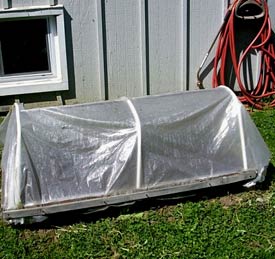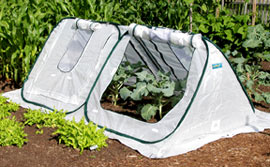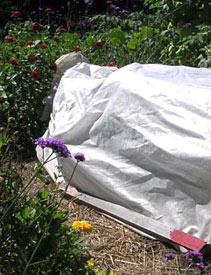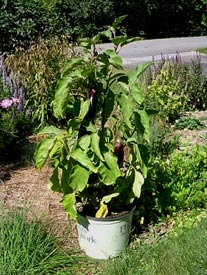
A homemade cold frame can be an effective way to extend your growing season in spring and fall. Place it on the southeast or southwest side of your house to protect it from cold northern winds.
There's a chill in the air and the garden is slowing down. While fall usually signals the time to pull annual plants and cut back perennials, it's also a time when, with a little effort, you can take steps to extend your growing season into autumn and early winter. Regardless of where you live in the country, fall weather can be a time to reap more harvest from your plants. The cooler weather and shorter days slow the growth of plants, allowing you to "catch up" with harvesting your favorites. For cool-season crops, such as broccoli, cabbage, kale, carrots, spinach, and radishes, the lower temperatures turn starches into sugars, creating a sweeter taste. Plus, these plants can take a light frost and still produce.
For warm-season crops, such as basil, tomatoes, squash, and cucumbers, you'll have to protect plants to eek out the last harvest in fall. One good thing about fall weather is that a cold snap will often be followed by weeks of warmer weather. Some people call it Indian summer. If you can get your annual plants through that first cold period, you can continue to harvest later into the season.
So, don't give up your garden yet. There are still a lot of vegetables, flowers, and herbs to be harvested! Here are some tips for extending the season.
Move Containers
Commercial cold frames feature convenient zippered doors and screen vents to keep the plants cool on sunny days.
Containers offer many advantages in the vegetable and herb garden, and one of the main ones is portability. Move containers to a protected spot when frost threatens. Even when frost isn't in the air, move the containers near a south-facing cement wall or dark building to concentrate the heat and sunlight. The wall and building absorb the sun's heat during the day and release it at night, which creates a slightly warmer microclimate. You can even protect containers when it gets really cold by grouping them together against a wall and making a tent out of clear plastic to drape over the containers without touching the plants. It's like building a mini-greenhouse!
Cover PlantsFor warm-season plants that aren't too large, such as basil, tomato, pepper, and eggplant, covering them up late in the day when frost is expected can add weeks to your harvest. Use a plastic bucket, old sheets, or burlap to protect your plants. Some types of commercial fabrics, such as floating row covers, can protect crops down to 20 degrees F. The point is to trap heat radiating up from the soil, so the drape should reach the ground and extend as far out as the plants' drip line. If possible, provide a framework over the plants to prevent the covering from touching the plant's foliage.

Floating row covers can be draped over plants in fall to protect them from the first frost. Some can protect plants down to 20 degrees F.
Remove the coverings in the morning once the air temperature reaches 60 degrees so the plants don't get too warm. The exception is floating row covers; they breathe so you can leave them on during the day without the plants overheating.
Build a Cold FrameIf you don't have a greenhouse, then a cold frame is the next best option. Essentially, a cold frame is a miniature greenhouse that protects plants from chilling winds and low temperatures. Some cold frames are constructed of plastic or nylon sheeting held aloft with wire hoops or wooden frames; others are made from rigid polycarbonate or even glass. As the sun passes through the clear or translucent covering, it warms the air and ground inside the cold frame. Some of this warmth is retained overnight when the outside temperature drops. You can add to the heat storage capacity of your cold frame by placing dark-colored plastic jugs filled with water in the unit. The sun warms the water in the jugs during the day and the heat radiates out at night to help keep plants warm. Some commercial cold frames have automatic venting systems so plants don't overheat on sunny days.
Probably the simplest cold frame consists of six hay bales arranged in a rectangle on the southern side of the house and topped with a storm window. Plant in the center of the bales underneath the glass.

Growing some vegetables, such as eggplant, in containers allows you to move the plants to a warmer location when cold weather strikes, protecting ripening fruit.
If you have an old storm window and some planks or scrap lumber, you can put together another easy cold frame. Nail the wood together to fit as the base under the storm window. Although commercial cold frames slant toward the sun, it's simpler to build it without the slant. Top it with the storm window. Skip the hinges — on hot days, slide the window to the side to let heat out. On cold nights, put the window squarely over the top of the frame and cover it with an old blanket.
It's best to plant cool season crops in early fall in your cold frame. Unless you're in the South, there won't be much growth in late fall and winter. However, some crops, such as spinach and kale, can overwinter in a cold frame in a cold climate and be one of the first crops you harvest in spring.
Other great season extending stories: Charlie Nardozzi is an award winning, nationally recognized garden writer, speaker, radio, and television personality. He has worked for more than 30 years bringing expert gardening information to home gardeners through radio, television, talks, tours, on-line, and the printed page. Charlie delights in making gardening information simple, easy, fun and accessible to everyone. He's the author of 6 books, has three radio shows in New England and a TV show. He leads Garden Tours around the world and consults with organizations and companies about gardening programs. See more about him at Gardening With Charlie.
Charlie Nardozzi is an award winning, nationally recognized garden writer, speaker, radio, and television personality. He has worked for more than 30 years bringing expert gardening information to home gardeners through radio, television, talks, tours, on-line, and the printed page. Charlie delights in making gardening information simple, easy, fun and accessible to everyone. He's the author of 6 books, has three radio shows in New England and a TV show. He leads Garden Tours around the world and consults with organizations and companies about gardening programs. See more about him at Gardening With Charlie.
 Victory Seed Company has all the seeds you want for your best garden in 2024.
Victory Seed Company has all the seeds you want for your best garden in 2024.
For 25 years, the family-owned Victory Seed Company has provided the highest quality vegetable, herb and flower seeds to families across the country. We are passionate about providing you the best seeds available that give excellent germination, robust plants, and the harvest you want. With a catalog of over a thousand varieties, we have everything, and our prices are the kinds that we'd want to pay. We have hundreds of yesterday's heirloom vegetables, as well as today's award winning hybrid selections. Get to know us by visiting our website and browsing through our online vegetable seed catalog.